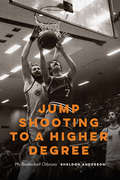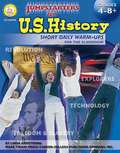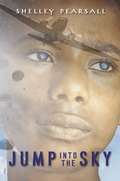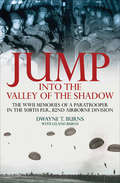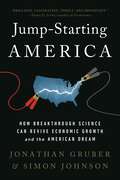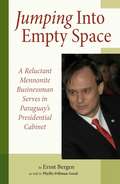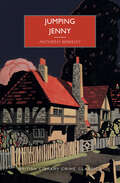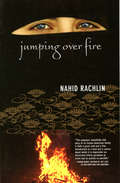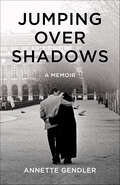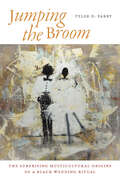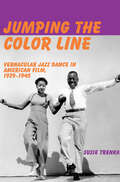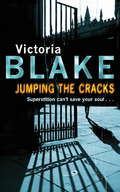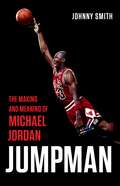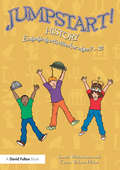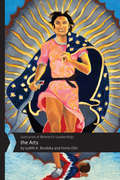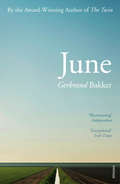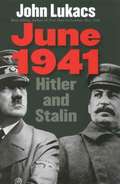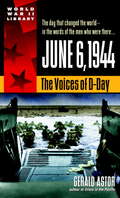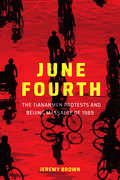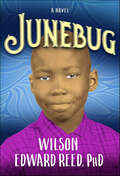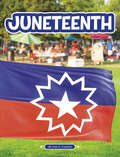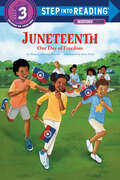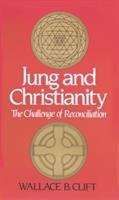- Table View
- List View
Jump Shooting to a Higher Degree: My Basketball Odyssey
by Sheldon AndersonJump Shooting to a Higher Degree chronicles Sheldon Anderson&’s basketball career from grade school in small-town Moorhead, Minnesota, in the 1960s, to inner-city high school and college ball in Minneapolis, to a professional career in West Germany, and finally to communist Poland, where he did PhD research while on a basketball junket behind the Iron Curtain in the late 1980s. Because he was the only American player in the league at the time, and with help from a Polish scholar, Anderson was one of the first Western scholars to gain access to Communist Party documents. He's also likely the only American scholar to have funded his research by playing semi-pro basketball in a communist country.Jump Shooting to a Higher Degree is much more than a basketball story. Anderson provides insights into the everyday lives of people behind the Iron Curtain, such as the English coach he played for in West Germany, an elderly woman he visited many times in East Germany, and a sailmaker&’s family he lived with in Warsaw. He reflects on German, Polish, and Cold War history, providing a commentary on the times and the places where he lived and played, and the importance of basketball along the way.
Jump into the Sky
by Shelley PearsallLevi Battle's been left behind all his life. His mother could sing like a bird and she flew away like one, too. His father left him with his grandmother so he could work as a traveling salesman--until Levi's grandmother left this world entirely. Now Levi's staying with his Aunt Odella while his father is serving in the U.S. Army. But it's 1945, and the war is nearly over, and Aunt Odella decides it's time for Levi to do some leaving of his own. Before he can blink, Levi finds himself on a train from Chicago to Fayettville, North Carolina, where his father is currently stationed--last they knew.So begins an eye-opening, life-changing journey for Levi. First lesson: there are different rules for African Americans in the South than there are in Chicago. And breaking them can have serious consequences. But with the help of some kind strangers, and despite the hindrances of some unkind ones, Levi makes his way across the United States--searching for his father and finding out about himself, his country, and what it truly means to belong.Shelley Pearsall has created an unforgettable character in Levi and gives readers a remarkable tour of 1945 America through his eyes. Jump into the Sky is a tour de force of historical fiction from a writer at the very top of her game.From the Hardcover edition.
Jump into the Valley of the Shadow: Into the Valley of the Shadow
by Dwayne T. Burns Leland BurnsA paratrooper&’s memoir of survival and close-quarters combat in WWII: &“Well worth reading&” (Flight Journal). When Dwayne Burns turned eighteen, he decided he wanted to fight alongside America&’s best. He joined the paratroopers and was assigned to the 508th Regiment of the 82nd Airborne Division. Little did he suspect that a year later he&’d be soaring in a flak-riddled C-47 over Normandy, part of the very spearhead of the Allied drive to seize back Europe. Burns landed behind German lines during the dark early hours of D-Day and gradually found other survivors of his division. The paratroopers fought on every side in a confused running battle through the hedgerows, finally making a stand in a surrounded farmhouse. With one room reserved for their growing piles of corpses, the paratroopers held their ground until finally relieved by infantry advancing from the beaches. After being pulled out of Normandy, the airborne troops were launched into Holland as part of Montgomery&’s plan to gain a bridgehead across the Rhine. This daytime jump was less confused than the nocturnal one, but there were more Germans than expected and fewer Allied forces in support. It was another maelstrom of point-blank combat in all directions, and though the 82nd achieved its objectives, the campaign as a whole achieved little but casualties. The 82nd had hardly refilled with replacements when the Germans broke through the US front in the Ardennes. The 82nd&’s paratroopers were put aboard trucks and hastened to stand in the way of the panzer onslaught. Passing through Bastogne, they went farther north to St. Vith, where the US 7th Armored and other divisions were reeling. The 82nd held its own with quickly assembled defense perimeters, allowing other units to escape. After beating off massive attacks by the German SS, the paratroopers were disgusted to hear that they, too, had been ordered to retreat. They didn&’t feel they needed to, but Monty was determined to &“tidy up the battlefield.&” On January 3, they counterattacked through the freezing hills, sealing off the Bulge and pursuing the Germans back into the Reich. In this work, Dwayne Burns, assisted by his son Leland (US Army, 1975–79), not only relates the chaos of combat but the intimate thinking of a young soldier thrust into the center of several of history&’s greatest battles. His memories provide a fascinating insight into the reality of close-quarters combat.
Jump-Starting America: How Breakthrough Science Can Revive Economic Growth and the American Dream
by Simon Johnson Jonathan GruberThe untold story of how America once created the most successful economy the world has ever seen and how we can do it again.The American economy glitters on the outside, but the reality is quite different. Job opportunities and economic growth are increasingly concentrated in a few crowded coastal enclaves. Corporations and investors are disproportionately developing technologies that benefit the wealthiest Americans in the most prosperous areas--and destroying middle class jobs elsewhere. To turn this tide, we must look to a brilliant and all-but-forgotten American success story and embark on a plan that will create the industries of the future--and the jobs that go with them.Beginning in 1940, massive public investment generated breakthroughs in science and technology that first helped win WWII and then created the most successful economy the world has ever seen. Private enterprise then built on these breakthroughs to create new industries--such as radar, jet engines, digital computers, mobile telecommunications, life-saving medicines, and the internet-- that became the catalyst for broader economic growth that generated millions of good jobs. We lifted almost all boats, not just the yachts.Jonathan Gruber and Simon Johnson tell the story of this first American growth engine and provide the blueprint for a second. It's a visionary, pragmatic, sure-to-be controversial plan that will lead to job growth and a new American economy in places now left behind.
Jumpin' Jim Crow: Southern Politics from Civil War to Civil Rights
by Jane Dailey, Glenda Elizabeth Gilmore & Bryant SimonWhite supremacy shaped all aspects of post-Civil War southern life, yet its power was never complete or total. The form of segregation and subjection nicknamed Jim Crow constantly had to remake itself over time even as white southern politicians struggled to extend its grip. Here, some of the most innovative scholars of southern history question Jim Crow's sway, evolution, and methods over the course of a century. These essays bring to life the southern men and women--some heroic and decent, others mean and sinister, most a mixture of both--who supported and challenged Jim Crow, showing that white supremacy always had to prove its power. Jim Crow was always in motion, always adjusting to meet resistance and defiance by both African Americans and whites. Sometimes white supremacists responded with increased ferocity, sometimes with more subtle political and legal ploys. Jumpin' Jim Crow presents a clear picture of this complex negotiation. For example, even as some black and white women launched the strongest attacks on the system, other white women nurtured myths glorifying white supremacy. Even as elite whites blamed racial violence on poor whites, they used Jim Crow to dominate poor whites as well as blacks. Most important, the book portrays change over time, suggesting that Strom Thurmond is not a simple reincarnation of Ben Tillman and that Rosa Parks was not the first black woman to say no to Jim Crow. From a study of the segregation of household consumption to a fresh look at critical elections, from an examination of an unlikely antilynching campaign to an analysis of how miscegenation laws tried to sexualize black political power, these essays about specific southern times and places exemplify the latest trends in historical research. Its rich, accessible content makes Jumpin' Jim Crow an ideal undergraduate reader on American history, while its methodological innovations will be emulated by scholars of political history generally. In addition to the editors, the contributors are Edward L. Ayers, Elsa Barkley Brown, W. Fitzhugh Brundage, Laura F. Edwards, Kari Frederickson, David F. Godshalk, Grace Elizabeth Hale, Jacquelyn Dowd Hall, Stephen Kantrowitz, Nancy MacLean, Nell Irwin Painter, and Timothy B. Tyson.
Jumping Into Empty Space: A Reluctant Mennonite Businessman Serves In Paraguay's Presidential Cabinet
by Ernst BergenErnst Bergen had good reason to say no when the President of his country asked him to join his cabinet. Massive corruption was considered the ordinary course of business in Paraguay and had driven it to near financial ruin. Bergen, at age 39, was among the most successful men in the country with not an ounce of interest in government politics. What's more, Bergen grew up in a Mennonite colony situated in the inhospitable wilderness of the Paraguayan Chaco. He belongs to a highly industrious religious people who, for reasons of history and theology, are acutely suspicious of being involved in government. Jumping Into Empty Space tells two stories: the beginning of a remarkable economic turn-around in a battered country at the hand of this fearless business strategist; and the emergence of a true leader, told with unusual honesty and wisdom. Not only did Bergen have his own hot temper to control, he had to face extraordinary special interests and decades of despair everywhere, including in the President's own party.Skyhorse Publishing, along with our Arcade, Good Books, Sports Publishing, and Yucca imprints, is proud to publish a broad range of biographies, autobiographies, and memoirs. Our list includes biographies on well-known historical figures like Benjamin Franklin, Nelson Mandela, and Alexander Graham Bell, as well as villains from history, such as Heinrich Himmler, John Wayne Gacy, and O. J. Simpson. We have also published survivor stories of World War II, memoirs about overcoming adversity, first-hand tales of adventure, and much more. While not every title we publish becomes a New York Times bestseller or a national bestseller, we are committed to books on subjects that are sometimes overlooked and to authors whose work might not otherwise find a home.
Jumping Jenny (British Library Crime Classics)
by Anthony Berkeley"A witty and tricky plot and a genuinely shocking conclusion."—Publishers Weekly, Starred ReviewA mystery dinner theater party thrown by local author with a taste "for rather gruesome humor" requires guests come dressed as infamous killers—Jack the Ripper, Dr. Crippen, and the like. Whatever could go wrong?Know-it-all amateur criminologist Roger Sheringham settles in for an evening of beer, small talk, and analyzing his companions. Ena Stratton, the host's sister-in-law, catches his attention. Her erratic mood swings and loud, gossipy talk is winning her more than a few enemies amongst the guests. When she's found dead, it's clear that one of the partygoers helped her to an early grave.Noticing a key detail that could implicate a friend in the crime, Sheringham decides to meddle with the scene and unwittingly makes himself a suspect.Tightly paced and cleverly defying the conventions of the classic detective story, Anthony Berkeley's dark sense of humor and taste for the macabre drive this 1933 classic.This edition includes an introduction by CWA Diamond Dagger and Edgar ® Award-winning author Martin Edwards.
Jumping Over Fire
by Nahid RachlinFleeing a neocolonial oil town in southern Iran as Khomeini rises to power, the Ellahi family emigrates to the US, where Nora and her adopted brother Jahan struggle to end their incestuous attachment, get through college, and forge independent lives. Confronted by anti-Iranian hostility, Jahan is drawn to Islam, ultimately going back to join the Iranian army to fight Saddam Hussein, while Nora takes advantage of the greater opportunities and personal freedom for women here.Nahid Rachlin is the Iranian-American author of Veils, Foreigner, Married to a Stranger, and The Heart's Desire. She teaches at New School University and the Unterberg Poetry Center in New York.
Jumping Over Shadows: A Memoir
by Annette GendlerThe true story of a German-Jewish love that overcame the burdens of the past. Finalist for the 2017 Book of the Year Award by the Chicago Writers Association “A book that is hard to put down.” —Jerusalem Post “This book confirms Annette Gendler as an indispensable Jewish voice for our time." —Yossi Klein Halevi, author of Like Dreamers "The ghosts of the past haunt a woman’s search for herself in this thoughtful, poignant memoir about the transformative power of love and faith.” —Hillary Jordan, author of Mudbound, now a Netflix movie “An exquisitely written conversion story which expounds upon personal and collective identity.” —Washington Independent Review of Books “A compelling, gracefully written memoir about the impact of the past on the present.” —Michael Steinberg, author of Still Pitching History was repeating itself when Annette fell in love with Harry, a Jewish man, the son of Holocaust survivors, in Germany in 1985. Her Great-Aunt Resi had been married to a Jew in Czechoslovakia before World War II―a marriage that, while happy, put the entire family in mortal danger once the Nazis took over their hometown in 1938. Annette and Harry’s love, meanwhile, was the ultimate nightmare for Harry’s family. Not only was their son considering marrying a non-Jew, but a German. Weighed down by the burdens of their family histories, Annette and Harry kept their relationship secret for three years, until they could forge a path into the future and create a new life in Chicago. Annette found a spiritual home in Judaism―a choice that paved the way toward acceptance by Harry’s family, and redemption for some of the wounds of her own family’s past.
Jumping the Broom: The Surprising Multicultural Origins of a Black Wedding Ritual
by Tyler D. ParryIn this definitive history of a unique tradition, Tyler D. Parry untangles the convoluted history of the "broomstick wedding." Popularly associated with African American culture, Parry traces the ritual's origins to marginalized groups in the British Isles and explores how it influenced the marriage traditions of different communities on both sides of the Atlantic Ocean. His surprising findings shed new light on the complexities of cultural exchange between peoples of African and European descent from the 1700s up to the twenty-first century. Drawing from the historical records of enslaved people in the United States, British Romani, Louisiana Cajuns, and many others, Parry discloses how marginalized people found dignity in the face of oppression by innovating and reimagining marriage rituals. Such innovations have an enduring impact on the descendants of the original practitioners. Parry reveals how and why the simple act of "jumping the broom" captivates so many people who, on the surface, appear to have little in common with each other.
Jumping the Color Line: Vernacular Jazz Dance in American Film, 1929–1945
by Susie TrenkaFrom the first synchronized sound films of the late 1920s through the end of World War II, African American music and dance styles were ubiquitous in films. Black performers, however, were marginalized, mostly limited to appearing in "specialty acts" and various types of short films, whereas stardom was reserved for Whites. Jumping the Color Line discusses vernacular jazz dance in film as a focal point of American race relations. Looking at intersections of race, gender, and class, the book examines how the racialized and gendered body in film performs, challenges, and negotiates identities and stereotypes. Arguing for the transformative and subversive potential of jazz dance performance onscreen, the six chapters address a variety of films and performers, including many that have received little attention to date. Topics include Hollywood's first Black female star (Nina Mae McKinney), male tap dance "class acts" in Black-cast short films of the early 1930s, the film career of Black tap soloist Jeni LeGon, the role of dance in the Soundies jukebox shorts of the 1940s, cinematic images of the Lindy hop, and a series of teen films from the early 1940s that appealed primarily to young White fans of swing culture. With a majority of examples taken from marginal film forms, such as shorts and B movies, the book highlights their role in disseminating alternative images of racial and gender identities as embodied by dancers – images that were at least partly at odds with those typically found in major Hollywood productions.
Jumping the Cracks
by Victoria BlakeMove over Morse - PI Sam Falconer is tougher than ever and ready to tackle the darker side of Oxford...Oxford: the city of dreaming spires and lofty knowledge. Or so they say. But for private investigator Sam Falconer, it seems to be a place of sin and secrets. And Sam's better placed than most to know - she grew up in an Oxford college and now she's back to set up a branch of her detective agency. And as ever, cases have a way of finding Sam. Soon she has a vanished man to find, a museum display of shrunken heads to protect, and - as a near-fatal chase proves -her own skin to save. For Sam, like the Oxford antiquities she's tracking, it seems the secrets of the past aren't easily escaped. A taut mix of classic crime, modern noir and psychological drama, this is Blake at her very best.
Jumpman: The Making and Meaning of Michael Jordan
by Johnny SmithHow Michael Jordan&’s path to greatness was shaped by race, politics, and the consequences of fame To become the most revered basketball player in America, it wasn&’t enough for Michael Jordan to merely excel on the court. He also had to become something he never intended: a hero. Reconstructing the defining moment of Jordan&’s career—winning his first NBA championship during the 1990-1991 season—sports historian Johnny Smith examines Jordan&’s ubiquitous rise in American culture and the burden he carried as a national symbol of racial progress. Jumpman reveals how Jordan maintained a &“mystique&” that allowed him to seem more likable to Americans who wanted to believe race no longer mattered. In the process of achieving greatness, he remade himself into a paradox: universally known, yet distant and unknowable. Blending dramatic game action with grand evocations of the social forces sweeping the early nineties, Jumpman demonstrates how the man and the myth together created the legend we remember today.
Jumpstart! History: Engaging activities for ages 7-12 (Jumpstart)
by Sarah Whitehouse Karan Vickers-HulseThis collection of simple to use and fun activities will jumpstart pupils’ understanding of the historical skills of chronology, enquiry, historical inference and knowledge and understanding of people, places and time. History is an effective way to engage pupils in a topic and can act as a fantastic hook for learning. This book will enable you to make history a fundamental part of your classroom, to enhance not only the pupils' historical understanding but also to deepen their understanding in other subjects. Areas covered include:- Egyptians Ancient Greeks and Romans Saxons, Vikings and Normans Stone Age Bronze Age Iron Age Tudors and Stuarts Victorians World War Two Post-War Britain This indispensable classroom resource will celebrate history and give children the opportunity to experience the thrill of finding out about the past. It will be a lifeline to any classroom teacher looking to teach history in a fun and exciting way.
Junctures in Women's Leadership: The Arts (Junctures: Case Studies in Women's Leade #3)
by Judith K. Brodsky Ferris OlinIn this third volume of the series Junctures: Case Studies in Women’s Leadership, Judith K. Brodsky and Ferris Olin profile female leaders in music, theater, dance, and visual art. The diverse women included in Junctures in Women's Leadership: The Arts have made their mark by serving as executives or founders of art organizations, by working as activists to support the arts, or by challenging stereotypes about women in the arts. The contributors explore several important themes, such as the role of feminist leadership in changing cultural values regarding inclusivity and gender parity, as well as the feminization of the arts and the power of the arts as cultural institutions. Amongst the women discussed are Bertha Honoré Palmer, Louise Noun, Samella Lewis, Julia Miles, Miriam Colón, Jaune Quick-To-See Smith, Bernice Steinbaum, Anne d’Harnoncourt, Martha Wilson, Jawole Willa Jo Zollar, Kim Berman, Gilane Tawadros, Joanna Smith, and Veomanee Douangdala.
June
by Gerbrand BakkerBy the award-winning author of The TwinOn a hot summer’s day in June 1969 everyone in the village gathered to welcome Queen Juliana. It would have been an unforgettable day of celebration if only the baker hadn’t been running late with his deliveries and knocked down little Hanne with his brand-new VW van.Years later, Jan arrives on a hot day in June in order to tidy his sister’s grave, and is overcome again with grief and silent fury. Isn’t it finally time to get to the bottom of things? June traces in spellbinding, tender detail how the ripples from one tragic incident spread through a community, a family and down the generations.‘Illuminating’ Independent‘Exceptional’ Irish Times
June 1941: Hitler and Stalin
by John LukacsThis brilliant new work by the author of the best-selling Five Days in London, May 1940 is an unparalleled drama of two great leaders confronting each other in June 1941. It describes Hitler and Stalin's strange, calculating, and miscalculating relationship before the German invasion of Soviet Russia, with its gigantic (and unintended) consequences. John Lukacs questions many long-held beliefs; he suggests, for example, that among other things Hitler's first purpose involved England: if Stalin's Communist Russia were to be defeated, Hitler's Third Reich would be well-nigh invincible, and the British and American peoples would be forced to rethink the war against Hitler. The book offers penetrating insights and a new portrait of Hitler and Stalin, moved by their long-lasting inclinations. Yet among other things, Lukacs presents evidence that Hitler (rather than his generals) had moments of dark foreboding before the invasion. Stalin could not, because he wished not, believe that Hitler would choose the risk of a two-front war by attacking him; he was stunned and shocked and came close to a breakdown. But he recovered, grew into a statesman, and eventually became a prime victor of the Second World War. Such are the ironies of history; John Lukacs paints them with a shining narrative skill.
June 6, 1944: The Voices of D-Day
by Gerald AstorIn ships and planes, they crossed the English Channel. On the other side Hitler's army waited. And the longest day was about to begin. . . . In the spring of 1944, 120,000 Allied soldiers crossed the English Channel in the most ambitious invasion force ever assembled. Rangers, paratroopers, infantry, and armored personnel, these soldiers--some who had just cut their teeth in Africa and Sicily and some who were brand-new to war--joined a force aimed at the heart of Europe and Hitler's defenses. On the morning of June 6, D-Day began. And in the hours that followed, thousands lost their lives, while those who survived would be changed forever No other chronicle of D-Day can match Gerald Astor's extraordinary work--a vivid first-person account told with stunning immediacy by the men who were there. From soldiers who waded through the bullet-riddled water to those who dropped behind enemy lines, from moments of terror and confusion to acts of incredible camaraderie and heroism, June 6, 1944 plunges us,into history in the making--and the most pivotal battle ever waged.
June Fourth: The Tiananmen Protests and Beijing Massacre of 1989 (New Approaches to Asian History)
by Jeremy BrownThe Tiananmen protests and Beijing massacre of 1989 were a major turning point in recent Chinese history. In this new analysis of 1989, Jeremy Brown tells the vivid stories of participants and victims, exploring the nationwide scope of the democracy movement and the brutal crackdown that crushed it. At each critical juncture in the spring of 1989, demonstrators and decision makers agonized over difficult choices and saw how events could have unfolded differently. The alternative paths that participants imagined confirm that bloodshed was neither inevitable nor necessary. Using a wide range of previously untapped sources and examining how ordinary citizens throughout China experienced the crackdown after the massacre, this ambitious social history sheds fresh light on events that continue to reverberate in China to this day.
Junebug: A Novel
by Wilson Edward ReedA fictionalized account of Wilson Edward Reed, PhD’s experience growing up Black in the South during the 1950’s and 60’s, Junebug is a middle-grade novel that shows how to move beyond hardships, like those many faced while living under Jim Crow. Full of humor and heartache, Junebug depicts a young person’s journey to find self-worth despite American society’s onslaught of negative messaging determined to define one’s identity and future—the kind that can come from any side. The story follows Junebug’s exploits with his friends, the loss of his mother, and his struggles with racial discrimination, before he sets his sights beyond Mississippi. After taking the 2,600 mile bus journey to Seattle, Junebug is encouraged by his three aunts to earn a college degree, all while his spiritual and emotional growth is on display. Like the Sankofa bird, Junebug is able to make peace with his past and use that knowledge to move forward as he takes responsibility for his mistakes and forgives those who hurt him. Junebug shows how familial support and community involvement can help motivated individuals rise above anger and discrimination and discover the life of their dreams.
Juneteenth
by Van G. GarrettA lyrical picture book about our newest national holiday, Juneteenth follows the annual celebration in Galveston, Texas—birthplace of Juneteenth—through the eyes of a boy coming to understand his place in Black American history in a story from three Texan creators.A young Black child experiences the magic of the Juneteenth parade for the first time with their family as they come to understand the purpose of the party that happens every year—and why they celebrate their African American history!The poetic text includes selected lyrics from “Lift Every Voice and Sing,” the unofficial Black National Anthem, and the vibrant art illuminates the beauty of this moment of Black joy, celebrated across the nation. This vibrant adventure through the city streets invites young readers to make a joyful noise about freedom for all.
Juneteenth (Tradiciones y celebraciones)
by Lisa A. CraytonDescubre y celebra Juneteenth con esta exploración fáctica de la historia, los eventos y las tradiciones de la festividad. Discover and celebrate Juneteenth with this factual exploration of the history, events, and traditions of the holiday.
Juneteenth: Our Day Of Freedom (Step into Reading)
by Sharon Dennis WyethSome call it Freedom Day; some call it Emancipation Day; some call it Juneteenth. Learn more about this important holiday that celebrates the end of chattel slavery in the United States in this Step 3 History Reader.On June 19, 1865, two years after the Emancipation Proclamation, a group of enslaved men, women, and children in Texas gathered. Order Number 3 was read, proclaiming that they were no longer enslaved--they were free. People danced, wept tears of joy, and began to plan their new lives. Juneteenth became an annual celebration that is observed by more and more Americans with parades, picnics, family gatherings, and reflection on the words of historical figures, to mark the day when freedom truly rang for all. Step 3 Readers feature engaging characters in easy-to-follow plots and popular topics--for children who are ready to read on their own.
Jung and Christianity: The Challenge of Reconciliation
by Wallace B. CliftA parish minister attempts to answer the challenge presented to Christianity in the last decade of Jung's life--to make the teachings real in this day and age, and offer true enlightenment of the soul.
